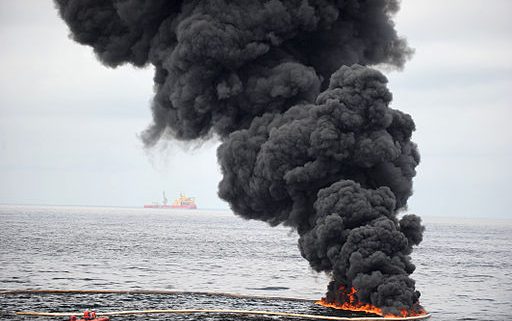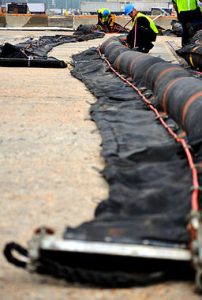A Review of Different Methods for Responding to an Oil Spill
by Jake Jerome, RJD Intern
There is no debate that an oil spill is devastating to the marine environment. While many oppose the idea of drilling for oil in the ocean, the fact remains that it is currently happening and will continue into the future. Whether it be from direct drill sites in the ocean or oil tankers traveling the seas, we need to be prepared when there is an accident and oil leaks into the ocean. As our past actions have revealed, we still have a lot to learn about how to cope with an oil spill. Because no one agrees that one method is perfect, it is important to be well informed on some options and seek input so that an educated decision can be made.
Once an oil spill occurs, the first action that should immediately take place is stopping the pollution from the source (5). This can sometimes prove to be difficult as we learned from the Deepwater Horizon Oil Spill in April 2010. Once the oil is stopped, a variety of cleanup methods can be deployed to cope with the disaster. Each cleanup method has pros and cons. A review of possible options follows.
Booms/skimmers:
Booms vary in type but all have the same general design: a sub-surface skirt that prevents oil from escaping below the floating boom, a flotation device, and tension on the boom (2). The purpose of booms are to contain surface oil within its boundaries so that collection of the oil can take place. Collection of the oil is often carried out by skimmers. Skimmers recover oil without altering its physical or chemical properties and can do so in a variety of ways, including suction and adhesion (5,2). While using booms and skimmers in conjunction is seen as the best option because the oil will be completely removed from the surface, it does face many challenges (2). One of the biggest limitations in the use of this method is surface conditions. Wind and waves encourage oil to carry out its natural tendency, to fragment and disperse itself in the water (2). Rough seas can prevent skimmers from functioning properly and can easily carry oil over the top of booms (2). Another downfall to this method is the ability to get the equipment operating and to the site in a timely manner. Even if the equipment is ready in a few hours, the oil will have had ample time to spread over several square kilometers, making the removal of the oil nearly impossible (2).
In situ burning:
In situ burning of surface oil involves a controlled ignition of spilled oil to essentially burn it off the surface of the water (5). In situ burning is often considered for Arctic or sub-Arctic environments because of their remoteness and sea ice formations that can constrict deployment of other methods (1). In situ burning has been shown to be less effective when used in ice corridors due to the high rate of melting sea ice (1). This reduces the thickness of oil, making it hard to ignite (1). In situ burning also presents environmental problems. Large clouds of black smoke rise from burning sites that not only pollute the air, but can impact communities both on the coast and far inland (2). In situ burning also leaves a residue that can coat coastlines or even worse, sink to cover benthic organisms (2).
Chemical dispersants:
Chemical dispersants are employed on oil spills for the purpose of accelerating the natural dispersion of oil in water (2). The dispersants release the tension between the oil and water and subsequently reduce the droplet size of the oil so it can be distributed in the water column (4). Once in small enough droplet sizes, the oil can be biodegraded by naturally occurring microorganisms (2). Chemical dispersants can quickly break up oil slicks and prevent large quantities of oil from covering coastlines and sensitive habitats. This method is considered to be a favorable option for coping with an oil spill. However, as in the other options, there are negative implications when using this method. There is great concern and debate that adding these chemical dispersants to the ocean is poisoning fish, corals, and other marine species. Goodbody-Gringley et al, found that the popular dispersant Corexit (R) 9500 significantly decreased the larval settlement and survival of two coral species. While this and other studies are telling, more research is needed to fully quantify the affect that dispersants have on the marine environment.
As you can see, choosing the correct method for cleaning up an oil spill can be difficult and is always situation dependent. There are many options that need to be considered before a decision is made, specifically determining the risks associated with each method. Although a quick response time is essential to eliminating a majority of the problems associated with an oil spill, more research needs to be done to help scientists fully understand the ramifications of each method. Overall effectiveness is vital, but unintended consequences must be weighed as well. For the present time these options appear to be the best available, but each should be weighed individually and in comparison to determine the most efficient and effect way to manage an environmental disaster such as an oil spill.
REFERENCES
Bellino, P.W., Rangwala, A.S., Flynn, M.R. “A study of in situ burning of crude oil in an ice channel” Proceedings of the Combustion Institute. Volume 34, Issue 2 (2013): 2539-2546
“Clean Up & Response.” ITOPF. N.p., 2013. Web. 28 Oct. 2013
Goodbody-Gringley, G., et al. “Toxicity Of Deepwater Horizon Source Oil And The Chemical Dispersant, Corexit® 9500, To Coral Larvae.” Plos ONE 8.1 (2013): 1-10
Kujawinski, E.B., Kido Soule, M.C., Valentine, D.L., Boysen, A.K., Longnecker, K., Redmond, M.C. “Fate of Dispersants Associated with the Deepwater Horizon Oil Spill” Environmental Science and Technology. 45. 4 (2011): 1298-1306
Ventikos, N.P., Vergetis, E., Psaraftis, H.N., Triantafyllou, G. “A High-Level Synthesis of Oil Spill Response Equipment and Countermeasures” Journal of Hazardous Materials. 107 (2004): 51-58







Leave a Reply
Want to join the discussion?Feel free to contribute!